Chapter 10: Books of prime entry and control accounts
Chapter learning objectives
Upon completion of this chapter you will be able to:
- identify the main data sources and records in an accounting system
- describe the contents and purpose of different types of business documentation
- outline the form of accounting records in a typical manual system
- record credit sale and purchase transactions (with and without sales tax) using day books
- post day book totals to the ledger accounts
- explain the division of the ledger into sections
- explain the nature and purpose of control accounts for the accounts receivable and accounts payable ledgers
- account for contras between trade receivables and payables
- record cash transactions using the cash book
- explain the need for a record of petty cash transactions
- illustrate the typical format of the petty cash book
- explain the importance of using the imprest system to control petty cash
- list the necessary controls and security over petty cash that would normally be found in a business
- explain the uses of the journal
- illustrate the use of the journal and the posting of journal entries into ledger accounts.
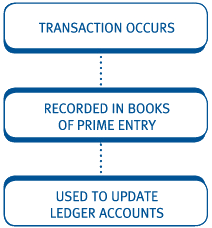
1 Business documentation
The table below summarises the main types of businessdocumentation and sources of data for an accounting system, togetherwith their content and purpose.


2 Accounting records
Books of prime entry
- If ledgers were updated each time a transaction occurred, the ledger accounts would quickly become cluttered and errors might be made.
- To avoid this, all transactions are initially recorded in a book of prime entry.
- Several books of prime entry exist, each recording a different type of transaction:
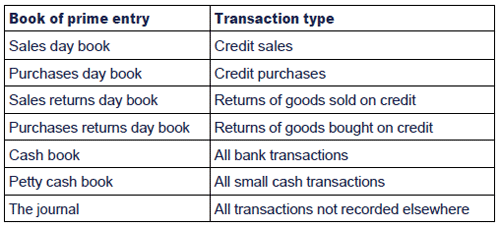
- Entry of a transaction to a book of prime entry does not record the double entry required for that transaction.
- The book of prime entry is, however, the source for double entries to the ledger accounts.
- The double entry arising from the book of prime entry will be recorded periodically (daily, weekly, monthly) depending on the volume of transactions.
3 Ledger accounts and the division of the ledger
In a manual system, ledgers can be thought of as books containing the individual accounts:
Where there are individual accounts in a receivables or payablesledger AND a control account in the general ledger, only one can formpart of the double entry system. The other exists for memorandumpurposes. It is normally the case that the control accounts form part ofthe double entry.

 Control accounts
Control accounts
Not all businesses maintain a receivables ledger control accountand purchases ledger control account, however where they do it isusually these control accounts that form part of the double entrysystem.
Where control accounts are maintained, they are effective inreducing the time it takes to ascertain the total amount owed byreceivables and owed to payables. The scope for making errors whenrealising these numbers through totalling several individual accounts isalso reduced.
Even where control accounts are maintained, a business must stillkeep a record of how much each customer owes them and how much they oweeach supplier, therefore the accounts payable ledger and accountsreceivable ledger are always part of the accounting system.

4 Sales and purchases day books
Sales day book
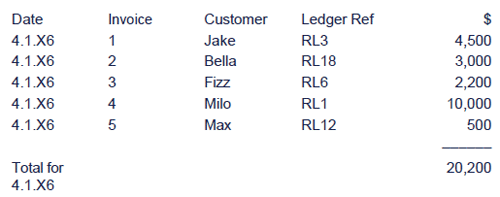
The format of the double entry resulting from the sales day bookwill depend upon whether the individual accounts in the accountsreceivable ledger OR the receivables control account in the generalledger is part of the double entry system:
Purchases day book, sales returns day book and purchases returns day book
The format of the remaining day books is similar to that of the sales day book. The double entries arising are:


 Format of purchase day book
Format of purchase day book
Format of the purchases day book
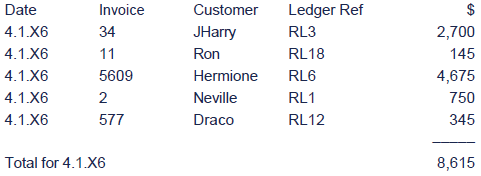
Dr Purchases $8,615
Cr Payables ledger control account $8,615
Individual purchases posted as credits to individual suppliers accounts in accounts payable ledger.
Format of the sales returns day book

Dr Sales returns $3,860
Cr Receivables ledger control account $3,860
Individual returns posted as credits to individual customers’ accounts in accounts receivable ledger.
Format of the purchases returns day book
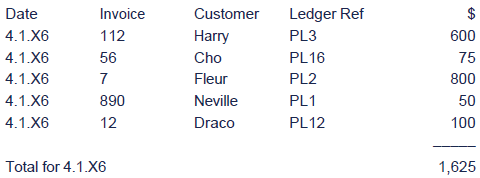
Dr Payables ledger control account $1,625
Cr Purchases returns $1,625
Individual returns posted as debits to individual suppliers accounts in accounts payable ledger.


 Illustration 1
Illustration 1
Mr Kipper-Ling runs a business providing equipment for bakeries.He always makes a note of sales and purchases on credit and associatedreturns, but he is not sure how they should be recorded for the purposesof his accounts.
Write up the following credit transactions arising in the first twoweeks of August 20X6 into day books and advise Mr Kipper-Ling of thecorrect double entries assuming that control accounts are maintained aspart of the double entry system.
1 August Mrs Bakewell buys $500 worth of cake tins.
1 August Mr Kipper-Ling purchases $2,000 worth of equipment from wholesalers TinPot Ltd.
2 August Mr Kipper-Ling returns goods costing $150 to another supplier, I Cook.
3 August Jack Flap buys $1,200 worth of equipment.
3 August Mrs Bakewell returns $100 worth of the goods supplied to her.
4 August Victoria Sand-Witch buys a new oven for $4,000.
5 August Mr Kipper-Ling purchases $600 worth of baking trays from regular supplier TinTin Ltd.
8 August Mr Kipper-Ling purchases ovens costing $10,000 from Hot Stuff Ltd.
8 August Mr Kipper-Ling returns equipment costing $300 to TinPot Ltd.
9 August Pavel Ova purchases goods costing $2,200.
11 August Mrs Bakewell buys some oven-proof dishes costing $600.


 Solution
Solution
Solution
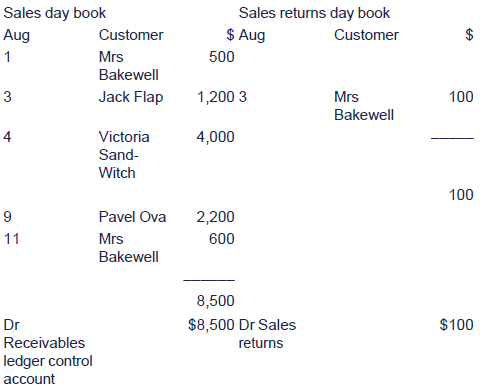
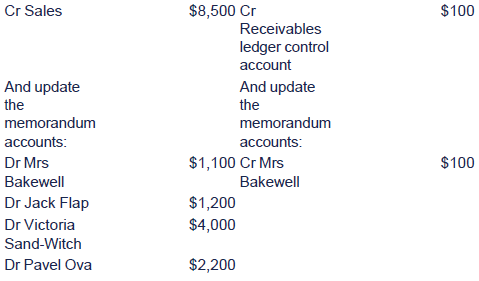
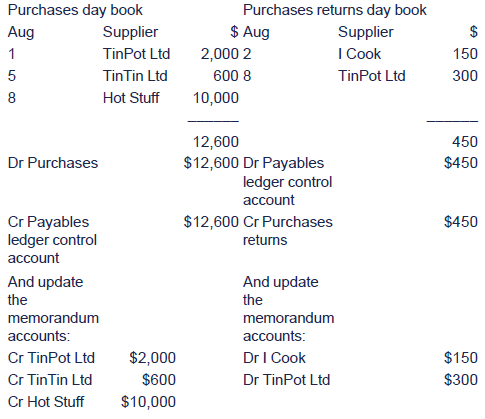

5 Sales tax in day books
If a business is registered for sales tax, the sales and purchases day books must include entries to record the tax.

 Illustration 2 – Sales tax in day books
Illustration 2 – Sales tax in day books
Sales day book

Purchases day book

What double entry arises from the day book?


 Solution
Solution
The double entry for the above transaction will be:
Dr Sales tax $315
Dr Purchases $1,800
Cr Payables ledger control account $2,115
The double entry for the above transaction will be:
Dr Receivables ledger control account $1,292.50
Cr Sales tax $192.50
Cr Sales $1,100.00


 Test your understanding 1
Test your understanding 1
The following sales invoices have been issued by Quincy in July:

Quincy is registered for sales tax, applied at a rate of 17.5%
What double entry arises from the day book?


 Control accounts
Control accounts
Control accounts are ledger accounts that summarise a large number of transactions.
Control accounts do form part of the double entry system.
The receivables ledger control account may include any of the following entries:
Receivables ledger control account
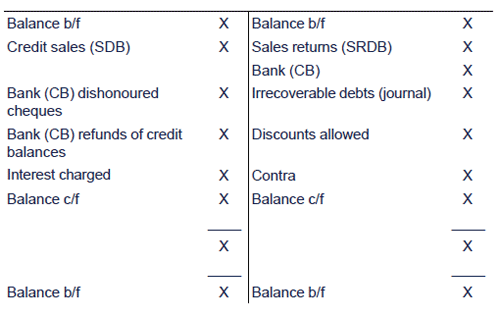
The payables ledger control account may include any of the following entries:
Payables ledger control account
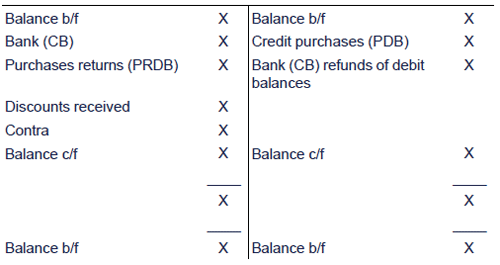
SDB Sales day book
PDB Purchases day book
SRDB Sales returns day book
PRDB Purchases returns day book
CB Cash book
Note that any entries to the control accounts mustalso be reflected in the individual accounts within the accountsreceivable and payable ledgers.

 Recording contra entries
Recording contra entries
Contra entries
The situation may arise where a customer is also a supplier.Instead of both owing each other money, it may be agreed that thebalances are contra’d, i.e. cancelled.
The double entry for this type of contra is:
Dr Payables ledger control account
Cr Receivables ledger control account
The individual receivable and payable accounts must also be updated to reflect this.


 Recording credit balances
Recording credit balances
Credit balances on the receivables ledger control account
Sometimes the receivables ledger control account may show a creditbalance, i.e. we owe the customer money. These amounts are usually smalland arise when:
- The customer has overpaid.
- Credit notes have been issued for fully-paid-for goods.
- Payment is received in advance of raising invoices.
The payables ledger control account may show a debit balance for similar reasons.


 Test your understanding 2
Test your understanding 2
Jones prepares monthly Receivables and Payables ledger controlaccounts. At 1 November 2005 the following balances existed in thecompany’s records.

The following information is extracted in November 2005 from the company’s records:

At 30 November 2005 the balances in the Receivables and Payables ledgers, as extracted, totalled:

Prepare the receivables ledger control account and the payablesledger control account for the month of November 2005 to determine theclosing debit and closing credit balances on the receivables ledgercontrol account and payables ledger control account respectively.

6 The cash book
- All transactions involving cash at bank are recorded in the cash book.
- Many businesses have two distinct cash books – a cash payments book and a cash receipts book.
- A note of cash discounts given and received is also recorded in the cash book. This is to facilitate the recording of discounts in both the general and accounts payable/receivable ledgers.
- It is common for businesses to use a columnar format cash book in order to analyse types of cash payment and receipt.

 Illustration 3 – The cash book
Illustration 3 – The cash book
The cash payments book
The following is the cash payments book of a small print business.

What are the accounting entries arising from the totals in the cashbook at the end of the day, assuming control accounts are kept?


 Solution to cash payments book
Solution to cash payments book
Solution
The cash transactions are recorded in total as follows:
Dr Payables ledger control account $3,210
Dr Rent expense $3,400
Cr Bank $6,610
The discount is recorded as follows:
Dr Payables ledger control account $180
Cr Discounts received $180
Entries must also be made to Mr A, Mr B and Mr C’s individualaccounts in the accounts payable ledger in order to reflect the paymentsmade and discounts received.


 Test your understanding 3
Test your understanding 3
The following is the cash receipts book of the SM Art Gallery.

What are the accounting entries arising from the totals in the cashbook at the end of the day, assuming control accounts are kept?

7 The petty cash book
- All transactions involving small amounts of cash are recorded in the petty cash book.
- The petty cash system is usually designed to deal with sundry small payments in cash made by a business, e.g. paying the milkman, purchasing biscuits, buying stationery or reimbursing travel expenses.
- The cash receipts will be recorded together with the payments which will be analysed in the same way as a cash book.

 The imprest system
The imprest system
The best way of dealing with petty cash is by means of an imprest system, which works as follows.
Step 1
The business decides on the amount of cash to be held as a float.
This round sum amount will be referred to as the ‘petty cash float’.
Step 2
As the petty cashier makes payments he records these in the pettycash book, which is not part of the double entry system. Allexpenditure must be evidenced by an expense receipt and the pettycashier will attach an expense voucher to each expense.
Step 3
When the petty cash runs low, a cheque is drawn to return thepetty cash to the exact amount of the original float. At this stage theexpense vouchers should be produced by the petty cashier to the chequesignatory which will exactly equal the cheque required.
This aspect of control is the essential feature of the petty cash system. At any stage:
Float = Cash in petty cash box + sum total of expense vouchers since last reimbursement

 Petty cash
Petty cash
Controls over petty cash
The following controls and security over petty cash should be found in a business:
- Petty cash must be kept in a petty cash box.
- Petty cash box must be secured in a safe.
- Person responsible for petty cash must be reliable and know what he/she is doing.
- All petty cash must be supported by invoices.
- Petty cash vouchers must be signed by the claimant and the person responsible for running the petty cash.
- Regular spot checks must be carried out to ensure that the petty cash is accurate.
Petty Cash Book
In this book the business will record small cash transactions.
- The cash receipts will be recorded together with the payments which will be analysed in the same way as a cash book. An imprest system will be adopted for the petty cash book.
- An amount is withdrawn from the bank account which is referred as a ‘petty cash float’.
This ‘float’ will be used to pay for the various sundry expenses. The petty cash book cashier will record any payments. - Any expenditure must be evidenced by an expense receipt and the petty cashier will attach a petty cash voucher to each expense.
- At any point in time the cash together with the expense vouchers should agree to the total float.
- At the end of the period the petty cash float is ‘topped up’ by withdrawing an amount from the bank totalling the petty cash payment made during the period.


 Illustration 4 – The petty cash book
Illustration 4 – The petty cash book
On 1 March 20X9 a petty cash float of $100 is introduced byDialex. During March the following payments are made out of petty cash:

On 31 March the cash is reimbursed. Write up the petty cash bookfor the month and show the resulting entries to the general ledger.


 Solution
Solution
Solution

No double entry bookkeeping entries are made from the receipts sideof the petty cash book – in a good system the only receipt should bethe reimbursement of the float, the double entry of which is dealt within the posting of the cash book.
As regards the payments, the double entry in the general ledger is performed as follows:




8 The journal
The journal is a book of prime entry which records transactionswhich are not routine (and not recorded in any other book of primeentry), for example:
- year-end adjustments
- depreciation charge for the year
- irrecoverable debt write-off
- record movement in allowance for receivables
- accruals and prepayments
- closing inventory
- acquisitions and disposals of non-current assets
- opening balances for statement of financial position items
- correction of errors.
The journal is a clear and comprehensible way of setting out a bookkeeping double entry that is to be made.
Presentation of a journal
A journal should be laid out in the following way:
to record the purchase of a new non-current asset.
A brief narrative should be given to explain the entry.

 Test your understanding 4
Test your understanding 4
Igor Romanov runs a Russian restaurant. He is a very good chefbut not quite so good at accounting and needs help to record thefollowing transactions:
(1) Closing inventory of 250 bottles of vodka at a cost of $2,750 has not been recorded.
(2) Igor needs to charge depreciation on his restaurant. He holds a 25-year lease which cost him $150,000 ten years ago.
(3) A regular customer, V Shady, keepsa tab behind the bar. He currently owes $350 but was last seen buying aone-way ticket to Moscow. Igor has given up hope of payment and intendsto write the debt off.
(4) On the last day of the year Igorbought two new sofas for cash for the bar area of the restaurant. Theycost $600 each but the purchase has not been reflected in the accounts.
What journals should Igor post?

Chapter summary
Test your understanding answers

 Test your understanding 1
Test your understanding 1
The correct answer is D
Sales day book

The double entry for the above transaction will be:



 Test your understanding 2
Test your understanding 2
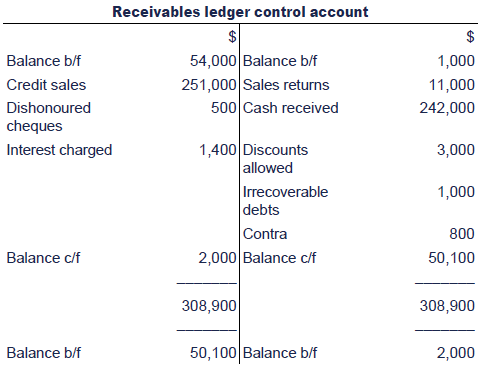
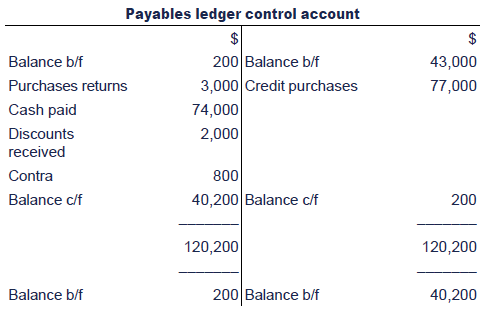


 Test your understanding 3
Test your understanding 3
The cash transactions are recorded in total as follows:
Dr Bank $48,820
Cr Receivables ledger control account $48,700
Cr Interest income $120
The discount is recorded as follows:
Dr Discounts allowed $800
Cr Receivables ledger control account $800
Entries must also be made to Monet, Gogh and Picasso’s individualaccounts in the accounts receivable ledger in order to reflect thepayments received and discounts allowed.


 Test your understanding 4
Test your understanding 4
(1) Dr Closing inventory (statement of financial position) $2,750
Cr Closing inventory (cost of sales) $2,750
To record the closing inventory of vodka.
(2) Dr Depreciation expense $6,000 ($150,000/25 yrs)
Cr Accumulated depreciation $6,000
To record depreciation on the restaurant lease.
(3) Dr Irrecoverable debt expense $350
Cr Receivables ledger control account $350
To record the write-off of a debt outstanding from V Shady.
NB Igor must also remember to update V Shady’s individual account in the accounts receivable ledger.
(4) Dr Fixtures and Fittings cost $1,200
Cr Cash $1,200
To record the purchase of two sofas for the bar.

|
Created at 5/24/2012 3:34 PM by System Account
(GMT) Greenwich Mean Time : Dublin, Edinburgh, Lisbon, London
|
Last modified at 5/25/2012 12:53 PM by System Account
(GMT) Greenwich Mean Time : Dublin, Edinburgh, Lisbon, London
|
|
|
|
 |
Rating
:
|
 Ratings & Comments
(Click the stars to rate the page) Ratings & Comments
(Click the stars to rate the page)
|
 |
Tags:
|
|
|
|
|